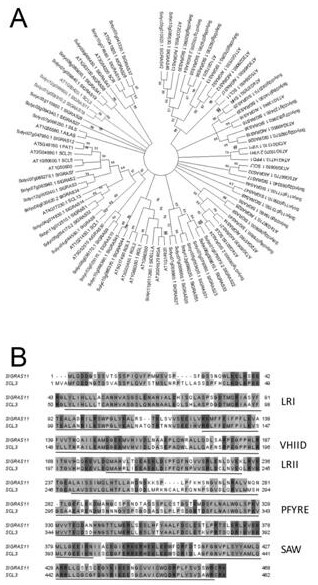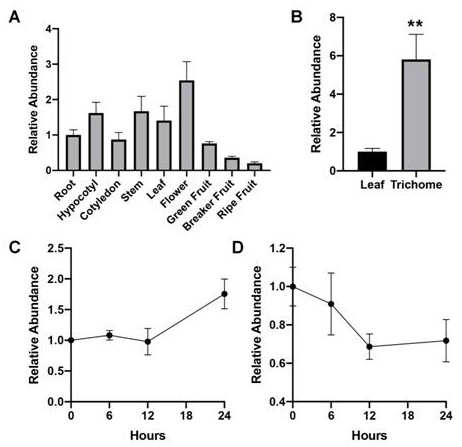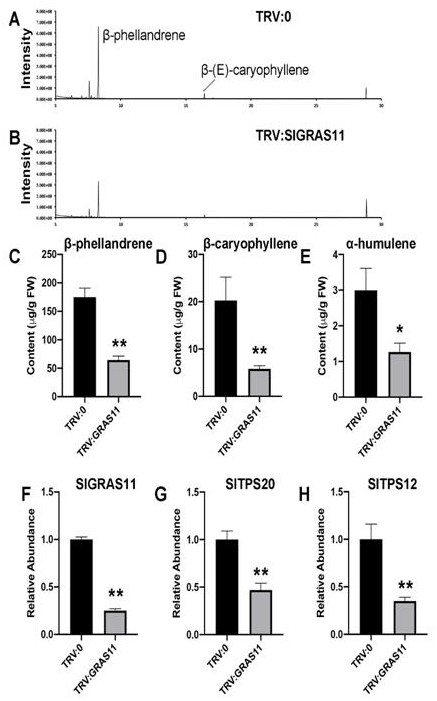Application of GRAS11 to regulation of synthesis of plant terpenoids and/or development of glandular hairs
A technology of terpenoids and plants, applied in the field of genetic engineering, can solve the problems of unclear regulation and weak regulation, and achieve the effects of improving insect and disease resistance, promoting the development of glandular hairs, and improving nutritional quality
- Summary
- Abstract
- Description
- Claims
- Application Information
AI Technical Summary
Problems solved by technology
Method used
Image
Examples
Embodiment 1
[0043] Example 1: Isolation and sequence analysis of GRAS11 gene fragments
[0044] The tomato leaf material was thoroughly ground in liquid nitrogen, transferred to a 2ml centrifuge tube, mixed with 1ml Trizol (Invitrogen, Cat. 15596-018), and left at room temperature for 5 minutes. Centrifuge at 12000rpm for 10min, and discard the precipitate. Add 0.2ml chloroform to the supernatant, mix well, and centrifuge at 12000rpm for 10min. Take the supernatant and add 0.5ml isopropanol to precipitate RNA. Centrifuge at 12000 rpm for 10 min, wash the precipitate with 75% ethanol, dry in vacuum, and dissolve in 50 μl of water.
[0045] Use RNA PCR system (TaKaRa, Cat.DRR019A) to synthesize cDNA, the reaction solution is: 10×RT buffer: 1 μl; dNTP: 1 μl; MgCl 2 : 2μl; Oligo dT: 0.5μl; RNA: 1μl; RNase Inhibitor: 0.5μl; AMV Reverse Transcriptase: 0.5μl; 2 O: 4 μl. The reaction conditions are: react at 42°C for 30 minutes, and react at 85°C for 5 minutes.
[0046] use FastPfu DNA Po...
Embodiment 2
[0049] Embodiment 2: vector construction
[0050] Using pEASY-GRAS11 as a template, the forward primer VIGS-GRAS11-F-BamHI (5'-GGATCCTTGATGTTGAGAAACTTCGC-3') and the reverse primer VIGS-GRAS11-R-XbaI (5'-TCTAGATGTCGAATCTTTGGAACCAC-3') were used for PCR amplification. Gene amplification, PCR amplification conditions: 95°C for 5min; 95°C for 30s, 55°C for 30s, 72°C for 30s; 30 cycles, recover target gene fragments after agarose gel electrophoresis. The gene fragment and the vector pTRV2 were double-digested with BamHI and XbaI respectively, and the digested products were recovered, mixed according to the molar ratio of the vector and the gene fragment at a ratio of 1:1, and ligated at 16°C for 30 minutes (Takara Company, DNA Ligation Kit Ver.2.1) . The ligation product was transformed into E.coli DH5α, spread on LB solid plates containing 50mg / L Kanamycin (Kan), and cultured in the dark at 37°C for 12-16 hours. Single colonies were picked for PCR clone screening, and positive ...
Embodiment 3
[0052] Example 3: Gene expression detection
[0053] The tomato leaves, roots and other materials were thoroughly ground in liquid nitrogen, transferred to a 2ml centrifuge tube, mixed with 1ml Trizol (Invitrogen, Cat. 15596-018), and left at room temperature for 5 minutes. Centrifuge at 12000rpm for 10min, and discard the precipitate. Add 0.2ml chloroform to the supernatant, mix well, and centrifuge at 12000rpm for 10min. Take the supernatant and add 0.5ml isopropanol to precipitate RNA. Centrifuge at 12000 rpm for 10 min, wash the precipitate with 75% ethanol, dry in vacuum, and dissolve in 50 μl of water.
[0054]Use RNA PCR system (TaKaRa, Cat.DRR019A) to synthesize cDNA, the reaction solution is: 10×RT buffer: 1 μl; dNTP: 1 μl; MgCl 2 : 2μl; Oligo dT: 0.5μl; RNA: 1μl; RNase Inhibitor: 0.5μl; AMV Reverse Transcriptase: 0.5μl; 2 O: 4 μl. The reaction conditions are: 42°C for 30 minutes, 85°C for 5 minutes.
[0055] CFX Connect Real-Time System (Bio-Rad Laboratories, I...
PUM
 Login to View More
Login to View More Abstract
Description
Claims
Application Information
 Login to View More
Login to View More - R&D
- Intellectual Property
- Life Sciences
- Materials
- Tech Scout
- Unparalleled Data Quality
- Higher Quality Content
- 60% Fewer Hallucinations
Browse by: Latest US Patents, China's latest patents, Technical Efficacy Thesaurus, Application Domain, Technology Topic, Popular Technical Reports.
© 2025 PatSnap. All rights reserved.Legal|Privacy policy|Modern Slavery Act Transparency Statement|Sitemap|About US| Contact US: help@patsnap.com



